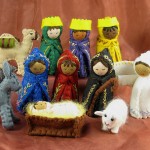
I read a story online today about a traditional nativity display in Santa Monica, California, that will not have its customary space along a street in a city park. The city uses a lottery system to give different groups the opportunity to set up their own displays in the park. This year, the Christian group that sets up the nativity scene – which usually includes fourteen different displays related to Jesus’s birth – was given only three spaces, apparently thanks to several atheists who entered the lottery for their own displays. The Christian group expressed their dismay at the atheists’ attempt to push them out of the park. They feel that their inability to express their religious beliefs is an infringement on their First Amendment rights.
That got me to thinking. Should the Christian version of Christmas be automatic in our culture? Should we always expect our traditional public nativity scenes to be accepted and allowed? Should the message of the birth of Jesus Christ become part and parcel of our cultural experiences?
These questions are related to a broader discussion in Christian circles: How should Christians interact with our culture? In his 1951 book Christ and Culture, Richard Niebuhr describes five possibilities:
- Christ against culture: The Christian church and secular culture have nothing to do with each other, and the good church will ultimately grow while the evil world fades away.
- Christ of culture: God works in and through our culture to fulfill his purposes. We find connections between the church and the best parts of culture.
- Christ above culture: There may be some similarities between the church and the world, but there are also many differences; the Christian way is often higher or better than the worldly way.
- Christ and culture in paradox: There is a tension between the church and the world, and that tension cannot be resolved.
- Christ transforming culture: The world is sinful, but Christ can transform culture so that it can serve his purposes.
Each of these ways of considering the relationship between Christ and culture has been used throughout history, and each has its strengths and weaknesses.
Should the Christian emphasis on Christmas be automatic in culture? If you say “yes” to that question, then you may be thinking in the “Christ of culture” way. I personally tend to fall toward the “Christ and culture in paradox” mindset.
My response to the Santa Monica nativity situation is to say this: The world might not understand or appreciate the Christian message of Jesus Christ being born in Bethlehem over 2,000 years ago, and that’s all right. Our task as believers is to be faithful to the message of Christ and to share it with those around us. If our communities do not accept that message, then so be it. That does not detract from the power of the gospel to change lives! In fact, it reminds us that our work is not complete. There are many who have not truly heard and understood the good news, that Jesus Christ is born – and that the rest of his story is true, as well!
Be encouraged, friends. We do not have to put Christ back into Christmas, because he has been there all along, calling us to be transformed and to leave behind the ways of the world, all for his name’s sake.
–Pastor David